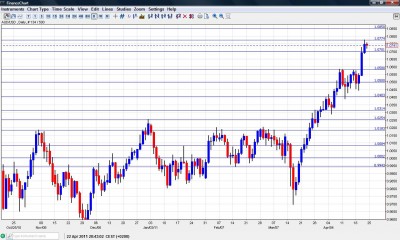The Australian dollar pushed forward to new historic highs, and enjoyed the dollar’s weakness. Will this continue? Quarterly CPI will set the tone in the upcoming week. Here’s an outlook for the Australian events and an updated technical analysis for AUD/USD.
The Aussie enjoyed the greenback’s weakness as well as its own strength. The stronger-than-expected PPI, at 1.2% in Q1, builds up expectations for the CPI release.
AUD/USD daily chart with support and resistance lines on it. Click to enlarge:
- CB Leading Index: Wednesday, 00:00. While most figures making this index have already been released, this indicator still tends to move the Australian dollar. This figure has recently seen one slow month followed by a stronger one. Last month witnessed a rise of only 0.1%. A stronger gain is likely now.
- CPI: Wednesday, 1:30. The main inflation figure is published in Australian only once per quarter, making this figure extremely important. The Aussie will rock on any outcome – a key for rate decisions. The releases for 2010 never exceeded expectations, and showed that inflation is under control. In Q4, consumer prices rose by only 0.4%, significantly lower than 0.7% that was expected. A rise of around 1% is more likely for the first quarter of 2011. It’s also important to note the Trimmed Mean CPI, similar to Core CPI in other countries. It rose by 0.3% in Q4 and is also likely to have accelerated in Q1.
- Private Sector Credit: Friday, 1:30. More credit means more economic activity. Last month saw a surprising rise of 0.5% in credit, more than 0.3% that was predicted. Another rise at the same scale can increase pressures for a rate hike.
* All times are GMT
AUD/USD Technical Analysis
After dipping below 1.05, the Aussie skyrocketed above the 1.0580 resistance line (mentioned last week) and climbed above 1.07 to close well above it, in a bullish week that followed the consolidation.
Looking down, the 1.07 line provides minor support after working as such in the past week. Much more important support is found at 1.0580, which capped the pair two weeks ago very stubbornly.
Moving lower, 1.05 is now minor support, after being broken just now. It’s followed by 1.04, which worked as support for another week.
Further down the road, we encounter 1.0315, which was a stepping stone for the Aussie on the long road higher, and is now only minor support. It’s followed by the important cushion of 1.0254, which was the peak of 2010.
Even lower, 1.0180 which was the previous high in November, and worked since then as a tough resistance line, provides support. It’s followed by 1.0080 was often support when the Aussie was trading at these highs and also worked as support.
AUD/USD parity lies belows, but it is weaker than earlier, though still of importance. Under parity, we find 0.9940, which provided support upon dips under parity.
Looking up, the past week’s peak and new multi-decade high of 1.0775 is the first line of resistance. Further resistance is at unchartered territory, with a possible barrier at 1.0850.
I remain bullish on AUD/USD
Even without the current extreme weakness of the US dollar (that could accelerate with the FOMC decision, the Aussie has plenty of reasons to rise: a strong economy enjoying a strong trade partner and a high interest rate. Will the rates need to rise further? We”ll get an significant clues now.
Further reading:
- For a broad view of all the week’s major events worldwide, read the USD outlook.
- For EUR/USD, check out the Euro/Dollar forecast.
- For the Japanese yen, read the USD/JPY forecast.
- For GBP/USD (cable), look into the British Pound forecast.
- For the New Zealand dollar (kiwi), read the NZD forecast.
- For USD/CAD (loonie), check out the Canadian dollar
- For the Swiss Franc, see the USD/CHF Forecast.

